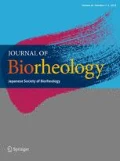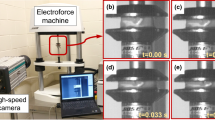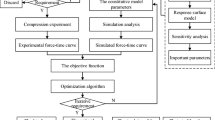Abstract
Recent experimental studies have highlighted the significant influence of axonal fibers on the nonlinear and anisotropic behavior of brain tissue. This study aims to implement these properties in a transversely isotropic visco-hyperelastic constitutive law for brain tissue. The second step consists in implementation of this law under finite-element (FE) code to improve brain FE modeling by including brain tissue specificities proposed in the recent literature. Validation of the model is shown by comparison of numerical simulation of unconfined compression with experimental tests from the literature. This study represents a step toward more realistic brain FE modeling.
Graphical Abstract











Similar content being viewed by others
Abbreviations
- F :
-
Deformation gradient tensor
- J :
-
Jacobian of the deformation (determinant of F)
- C :
-
Right Cauchy–Green deformation tensor
- W :
-
Strain energy function
- I i :
-
(i = 1, 2, 3, 4, 5) invariants of C
- K :
-
Bulk modulus
- G :
-
Shear modulus
- λ i :
-
(i = 1, 2, 3) principle stretches of F
- S :
-
Second Piola–Kirchhoff stress tensor
- σ :
-
Cauchy stress
- N :
-
Nominal stress tensor
References
Al-Bsharat A, Hardy W, Yang K, Kahlil T, Tashman S, King A. Brain/skull relative displacement magnitude due to blunt head impact: new experimental data and model. In: Proc. 43th stapp car crash Conf., 1999. Warrendale: Society of Automotive Engineers; 1999. p. 321–32.
Arbogast KB, Margulies SS. Material characterization of the brainstem from oscillatory shear tests. J Biomech. 1998;31:801–7.
Arbogast KB, Meaney DF. Biomechanical characterization of the constitutive relationship of the brainstem. In: Proceedings of the Society of Automotive Engineers, 1995. p. 153–9.
Ashby MF, Jones DRH. Matériaux 1. Propriétés et applications. 3rd ed. Dunod, 2008.
Bandak FA, Van Der Vorst MJ, Stuhmiller LM, Mlakar PF, Chilton WE, Stuhmiller JH. An imaging based computational and experimental study of skull fracture: finite element model development. In: Proc. of the head injury symposium, Washington DC, 1994.
Brands DWA. Predicting brain mechanics during closed head imapect—numerical and constitutive aspects. Ph.D. Dissertation Thesis, 2002. University of Eindhoven, Eindhoven.
Chatelin S, Deck C, Renard F, Kremer S, Heinrich C, Armspach J-P, Willinger R. Computation of axonal elongation in head trauma finite element simulation. J Mech Behav Biomed Mater 2011. ISSN 1751-6161, 10.1016.
Chatelin S, Constantinesco A, Willinger R. Fifty years brain tissue mechanical testing: from in vitro to in vivo investigations. Biorheology. 2010;47:255–76.
Criscione JC, Douglas AS, Hunter WC. Physically based strain invariant set for materials exhibiting transversely isotropic behavior. J Mech Phys Sol. 2001;49:871–97.
DiMasi F, Marcus J, Eppinger R. 3D anatomic brain model for relating cortical strains to automobile crash loading. In: Proc. of the international technical conference on experimental safety vehicles, NHTSA, vol. 2, 1991. p. 916–23.
Estes MS, McElhaney JH. Response of brain tissue to compressive loading. In: Proc. of the 4th ASME Biomechanics Conf., 1970, 70-BHF-13.
Franceschini G, Bigoni D, Regitnig P, Holzapfel GA. Brain tissue deforms similarly to filled elastomers and follows consolidation theory. J Mech Phys Solids. 2006;54:2592–620.
Fung YC. Biomechanics: mechanical properties of living tissues. NY: Springer; 1981.
Horgan TJ. A finite element model of the human head for use in the study of pedestrian accidents. PhD thesis, 2005. University of Dublin, Ireland.
Hosey RR, Liu YK. A homeomorphic finite element model of impact head and neck injury. I.C.P. Finite Elements Biomech. 1980;2:379–401.
Hrapko M, van Dommelen JAW, Peters GWM, Wismans JSHM. The influence of test conditions on characterization of the mechanical properties of brain tissue. J Biomech Eng. 2008;130(3):031003–10.
Kang HS, Willinger R, Diaw BM, Chinn B. Validation of a 3D human head model and replication of head impact in motorcycle accident by finite element modeling. In: Proc. 41th stapp car crash conf. Lake Buena Vista: Society of Automotive Engineers; 1997. p. 329–38.
King A, Yang K, Zhang L, Hardy W. Is head injury caused by linear or angular acceleration? In: IRCOBI conference, 2003. p. 1–12.
Kleiven S. Predictors for traumatic brain injuries evaluated through accident reconstruction. In: Proc. 51th stapp car crash conf. Society of Automotive Engineers paper 2007-22-0003. p. 81–114.
Kleiven S, Hardy WN. Correlation of an FE model of the human head with experiments on localized motion of the brain-consequences for injury prediction. Stapp Car Crash J. 2002;46:123–44.
Kruse SA, Rose GH, Glaser KJ, Manduca A, Felmlee JP, Jack CR Jr, Ehman R. Magnetic resonance elastography of the brain. NeuroImage. 2007;39:231–7.
LeBihan D, Mangin J-F, Poupon C, Clark CA, Pappata S, Molko N, Chabriat H. Diffusion tensor imaging: concepts and applications. J Magn Reson Imaging. 2001;13:534–46.
Mendis K. Finite element modelling of the brain to establish diffuse axonal injury criteria. PhD dissert, 1992, Ohio State University.
Miller K, Chinzei K. Mechanical properties of brain tissue in tension. J Biomech. 2002;35(4):483–90.
Miller K, Chinzei K. Constitutive modeling of brain tissue: experiment and theory. J Biomech. 1997;30:1115–21.
Nelder JA, Mead R. A simplex method for function minimization. Comput J. 1965;7:308–13.
Nicolle S, Lounis M, Willinger R. Shear properties of brain tissue over a frequency range relevant for automotive impact situations: new experimental results. Stapp Car Crash J. 2004;48:239–58.
Ning X, Zhu Q, Lanir Y, Margulies SS. A transversely isotropic viscoelastic constitutive equation for brainstem undergoing finite deformation. J Biomech Eng T ASME. 128;2006:925–33.
Pervin F, Chen WW. Dynamic mechanical response of bovine gray matter and white matter brain tissues under compression. J Biomechanics. 2009;42:731–5.
Prevost TP, Balakrishnan A, Suresh S, Socrate S. Constitutive response of brain tissue. Acta Biomateriala. 2010;7:83–95.
Puso MA, Weiss JA. Finite element implementation of anisotropic quasilinear viscoelasticity. ASME J Biomech Eng. 1998;120(1):62–70.
Rashid B, Destrade M, Gilchrist MD. Modelling and simulation of brain tissue in tension and compression at high strain rates. In: Workshop on computational mechanics of materials, Limerick, 2011.
Rivlin RS, Saunders DW. Large elastic deformations of isotropic materials VII. Experiments on the deformation of rubber. Phil. Trans. Roy. Soc. London A. 1951;243:251–88.
Ruan JS, Kahlil T, King AI. Human head dynamic response to side impact by finite element modeling. J Biomech Eng. 1991;113:276–83.
Shuck LZ, Advani SH. Rheological response of human brain tissue in shear. J Basic Eng. 1972;94:905–11.
Shugar TA. A finite element head injury model. Report No DOT HS 289-3-550-TA, vol. 1, 1977.
Spencer AJM. Continuum theory of the mechanics of fiber-reinforced composites. New York: Springer; 1984.
Takhounts EG, Eppinger RH, Campbell JQ, Tannous RE, Power ED, Shook SS. On the development of the SIMon finite element head model. Stapp Car Crash J. 2003;47:107–33.
Takhounts EG, Hasija V, Ridella SA, Tannous RE, Campbell JQ, Malone D, Danelson K, Stitzel J, Rowson S, Duma S. Investigation of traumatic brain injuries using the next generation of simulated injury monitor (SIMon) finite element head model. Stapp Car Crash J. 2008;52:1–32.
Taylor Z, Comas O, Cheng M, Passenger J, Hawkes D, Atkinson D, Ourselin S. On modelling of anisotropic viscoelasticity for soft tissue simulation: numerical solution and gpu execution. Med Image Anal. 2009;13:234–44.
Tiret L, Hausherr E, Thicoipe E, Garros B, Maurette P, Castel JP, Hatton F. The epidemiology of head trauma in Aquitaine (France), a community-based study of hospital admissions and deaths. Int J Epidemiol. 1986;19(1):133–40.
Velardi F, Fraternali F, Angelillo M. Anisotropic constitutive equations and experimental tensile behavior of brain tissue. Biomech Model Mechanobiol. 2006;5(1):53–61.
Ward CC, Chan M, Nahum AM. Intracranial pressure: a brain injury criterion. In: Proc. 24th stapp car crash Conf., SAE paper, 1980;80:1304.
Weiss J, Maker B, Govindjee S. Finite element implementation of incompressible, transversely isotropic hyperelasticity. Comput Methods Appl Mech Eng. 1996;135:107–28.
Zhang L, Yang K, Dwarampudi R, Omori K, Li T, Chang K, Hardy W, Kahlil T, King A. Recent advances in brain injury research: a new human head model development and validation. Stapp Car Crash J. 2001;45:396–93.
Zhang M, Mak AFT. In vivo friction properties of human skin. Prosthet Orthot Int. 1999;23:135–41.
Zhou C, Khalil TB, King AI. A 3D human finite element head for impact injury analyses. In: Symposium proc. of prevention through biomechanics, 1995. p. 137–48.
Author information
Authors and Affiliations
Corresponding author
Electronic supplementary material
Below is the link to the electronic supplementary material.
About this article
Cite this article
Chatelin, S., Deck, C. & Willinger, R. An anisotropic viscous hyperelastic constitutive law for brain material finite-element modeling. J Biorheol 27, 26–37 (2013). https://doi.org/10.1007/s12573-012-0055-6
Received:
Accepted:
Published:
Issue Date:
DOI: https://doi.org/10.1007/s12573-012-0055-6




